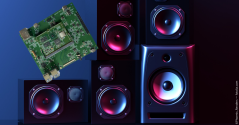New AP72611 System-on-Module for Advanced IoT

AMPAKs SOM Based on SYNAPTICS SL1620
AMPAK has introduced the AP72611, a system-on-module (SOM) based on SYNAPTICS‘ SL1620, a member of the latest Astra-enabled SoC family. The SL1620 features a quad-core Arm Cortex-A55 processor with speeds up to 1.9GHz and an Imagination BXE-2-32 GPU.
SAMPLES DOWNLOAD DATASHEETOptimised for Multi-Modal Consumer, Enterprise and Industrial IoT
The SYNAPTICS SL series of embedded processors provides highly integrated AI-native Linux and Android SoCs, optimised for multi-modal consumer, enterprise and industrial IoT workloads with hardware accelerators for edge inferencing, security, video, graphics and audio.
The SL1620 is tailored and optimised for embedded applications requiring robust processing, advanced AI capabilities and 3D graphics support. This chip includes Linux OS, advanced audio algorithms, a range of peripheral options, support for dual displays and a companion SYNAPTICS SoC for connectivity and audio frontend functionality.
It incorporates high-performance computing components, including a quad-core Arm Cortex-A55 CPU subsystem, a high-efficiency, feature-rich GPU for advanced graphics and AI acceleration, advanced audio algorithms, and dual display capabilities. The SL1620 supports the SYNAPTICS Astra IoT platform, providing a unified experience through standards-based approaches, open software frameworks and comprehensive AI toolkits. In conjunction with SYNAPTICS’ wireless connectivity solutions, the SL1620 enables cost-effective system solutions with performance-per-watt advantages for the IoT.
For connectivity, the AMPAK AP72611 includes the SYNAPTICS SY43711 Wi-Fi6E 1x1 radio module. This is an ultra-low-power solution with high data throughput that is also suitable for battery-powered applications.
Reduced Size, Power Consumption and Complexity
The SYN43711 integrates Wi-Fi6/6E and Bluetooth 5.3 radios on a single state-of-the-art SoC, reducing the size, cost, power consumption, complexity and time-to-market of wirelessly enabled IoT devices. The Wi-Fi radio complies with IEEE 802.11ax and supports legacy standards such as 802.11a/b/g/n/ac, offering a throughput of up to 600Mbps with a 1x1 antenna configuration. The Bluetooth 5.3 radio features LE Audio for multiple simultaneous Bluetooth audio streaming connections.
The SOM is supported by the SYNAPTICS‘ ASTRA software framework, which provides a comprehensive software environment to seamlessly integrate AI models or custom models and run them on the Arm quad-core processor or GPU. ASTRA can be downloaded from GitHub after registration, with no additional cost.
Product Features, Interfaces and Memory Configuration
- CPU
- Quad-core Arm® Cortex®-A55 up to 1.9GHz
- GPU
- Imagination™ BXE-2-32 / Dual core (2 pixels per clock)
- Clock frequency up to 800MHz
- Supports OpenGL® ES™ 3.2, OpenCL™ 3.0, EGL™ 1.5, Vulkan® 1.3, Android™ NN API through IMGDNN AP
- Security
- On-chip 32Kbit anti-fuse OTP
- True random number generator
- DRM engine supports
- AES, DES, 3DES, SHA1/SHA2/MD5, RSA, ECC
- Audio
- TDM//PDM and DVFA audio
- 8 to 96/192 kHz and slot size 8/16/24/32bit
- Memory Interfaces
- DRAM 32bit DDR4- 2666 up to 8 GB memory space
- 4Gb NAND 8bit Parallel SLC (64bit ECC per 2KB of data)
- Peripherals
- One USB 3.0 Host and One USB 2.0 On-The-Go (OTG) interface
- Four TWSI 2-wire buses (I2C compatible) and two high speed UART interfaces
- Two SPI controllers and up to four slave devices supported on each interface
- 72bit pin-shared GPIOs
- Rectangular Keyboard matrix controller up to 80 keys (8x10)
- 4 PWMs and On-chip temperature sensor
- Video/Display Interfaces
- MIPI Display Serial Interface (DSI) up to 1080p60 screen resolution
- RGB Digital Parallel Interface (DPI)/CPU-type Display Bus Interface (DBI)
- RGB 16bpp (565), 18bpp (666) and 24bpp (888) output formats
- 1080p30 screen resolution and refresh rate
- Ethernet
- 802.3(G)MAC supports RGMII and RMII
- 802.1 p/q tagging (VLAN) in hardware
- IEEE 1588 Precision Time Protocol (PTP) with PPS output signal
- IEEE 802.11 Key Features
- TX and RX low-density parity check (LDPC) support for improved range and power efficiency
- Dual-stream spatial multiplexing up to 1200Mbps data rate
- 20/40/80MHz channels for 5GHz and 6GHz radio, and 20MHz channels for 2.4GHz radio
- Client MU-MIMO
- Bluetooth Key Features
- Complies with Bluetooth Core Specification Version 5.3 with provisions for supporting future specifications. With Bluetooth Class 1 or Class2 transmitter operation
Your Contact Person
For more information, please contact Achim Stahl.

